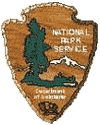
Twickenham
by Ted Fremd
"The coyotes howl for Twickenham,
The bobcats prowl in Twickenham,
But do not go to Twickenham
If seeking dive or joint.
There is no jail in Twickenham,
There's little mail in Twickenham,
But I'd choose a Twickenhammer
For driving home a point".
(From "Wheeler County's Past", 1957)

Photo: 1930's expedition to Twickenham leaf site / 1998 visit
Very few eastern Oregon residents are aware of a classic, important plant fossil site near the hamlet of Twickenham on the John Day River, a community that (as the above verse suggests) definitely isn't overpopulated. This summer, on one of the hottest days on record, we visited this site, taking along an old photograph from one of the early expeditions (see photo). We wanted to relocate the original collecting locality and put it into context with the rest of the "Bridge Creek Floras" that existed 34 million years ago. Along with the usual field crew, we had a long term volunteer from England who, coincidentally, attended school in "The" Twickenham on the River Thames and was thrilled to be visiting the North American namesake. She admitted our version was a bit drier and a lot more deserted. After a day cracking rocks and swinging heavy hammers in dusty 113 degree heat, though, she was probably the only one of us left with any enthusiasm for the project….
The Twickenham leaf site was probably collected by members of the U.S. cavalry as early as the 1860's, but the classic paper on the petrified leaves was only written 50 years ago. We were eager to re-examine these beds using newer methods and data protocols. I was delighted to see that rather than a single layer of fossils, the site actually consists of a thick sequence of unusually varied lake beds, containing abundant seams of lignite (a substance that formed from the remains of mats of vegetation, somewhere between peat and coal). The well-preserved fossils are found in many of these shale beds, collected by carefully splitting the rock with chisels. While I measured the section and described the sequence of rocks in my notes, the rest of the crew located and collected leaves from the ancient maples, "dawn redwoods", and elms that lived in a forest millions of years ago in what is now a dry, sagebrush covered area.
Back in the "good old days", collectors would work these kinds of sites by excavating as many good fossil leaves as they could, with a bias for keeping only the complete or especially well-preserved specimens, and no effort was made to assign each specimen to an exact layer of rock. We still are prone to doing some "high-grading", but now we pay much more attention to the details and try to tie each fossil to precise laminations. It's not only the "devil that's in the details": so are important clues to the nature of environmental change and climate alterations that are preserved in the rocks. These floras changed rapidly over geologic time. What we see is a sequence of lake beds separated by drying episodes and the formation of soils (now turned to rock), followed by more lakebeds, over and over for periods of time representing hundreds of thousands of years.
To lump all of these time intervals together (as the early collectors did) is to miss the details of the changes in these communities. For example, when the old collections from "Twickenham" were all curated as a single locality, with no separation of the specimens by strata, the effect was to mix distinct times and ecosystems into one artificial assemblage. As a result, the reconstructions of the floras were odd, to say the least.
To use a spatial metaphor, it would be as if a botanist collected plants from the top of Strawberry Mountain, then along the Middle Fork of the John Day, mixed in some cacti from the cliffs near Kimberly; and from this hodge-podge attempted to reconstruct the flora of Dayville. Put together, such lumping of collections only confuses the attempt to understand what the ancient ecosystem was like, and how it evolved. Our new collections fit into a framework of time that helps prevent such ‘blurring' of ancient times.
The FOSSIL RECORD is a monthly column written by the paleontologist at John Day Fossil Beds for local newspapers in Eastern Oregon...
fossil-record/8.htm
Publication Date: 10/21/1998